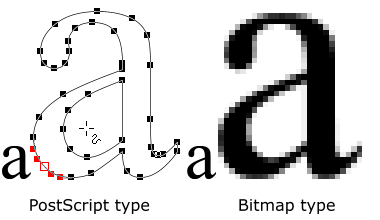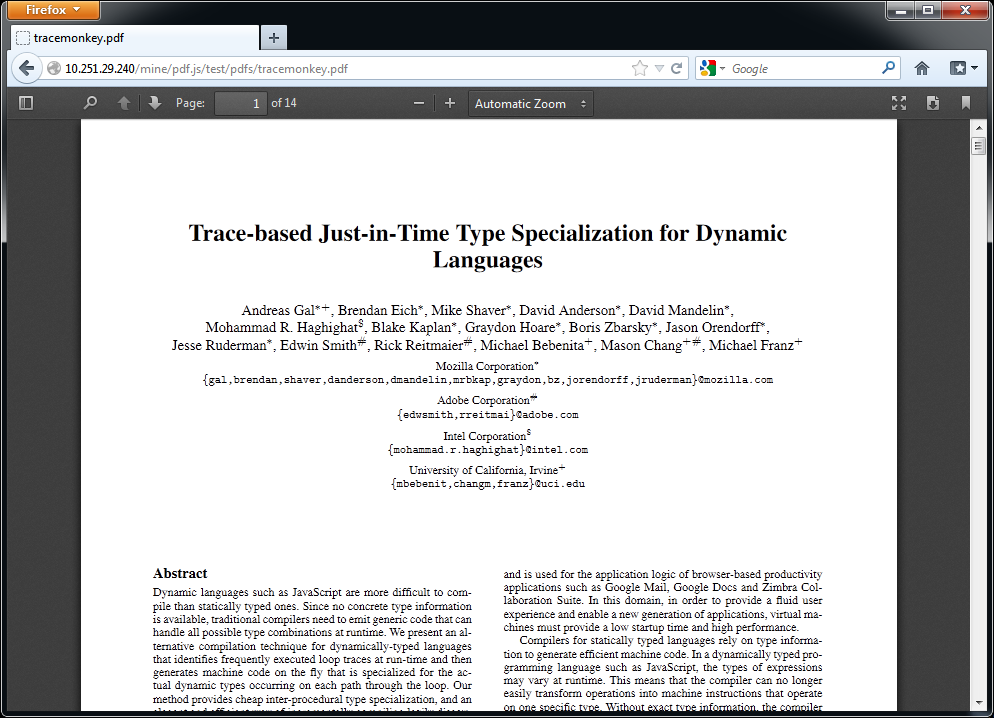| [Adobe PDF icon, courtesy Wikipedia] |
Printing, fonts, and font rendering was standardized on the PostScript language. This grew into PDF, where individual pages would be rendered. Change continues to press on, with Adobe buying Frame Technologies, Oracle buying Sun Microsystems, and now Mozilla Foundation is moving web browsers like FireFox to render PDF natively via JavaScript.
 |
| [PostScript to bit map font, courtesy xaraxone] |
PostScript
PostScript language was born in 1976 by John Warnock. The first laser printers used it in Xerox PARC in between 1975-1976. Adobe was founded in 1982, Warnock a co-founder, and Steve jobs visited around 1984, and encouraged them to use PostScript to drive laerprinters. PostScript and Laser Printers merged, and the Apple LaserWriter was released in 1985.
| [Adobe FrameMaker logo, courtesy Wikipedia] |
Adobe, with desktop publishing packages (like FrameMaker, from Frame Technologies, later purchased by Adobe) creating the UNIX Workstation market. Quark's Xpress created the desktop Publishing Market, predominately under Apple systems. PostScript was embedded into the OS layer for displays on workstation vendors such as Sun Microsystems (NeWS) and NeXT (Display Postscript) and even a subset on PC's such as the Apple Macintosh (QuickDraw.)
| [QuarkXpress Logo, courtesy Wikipedia] |
PDF was later created by Adobe, to allow the display of a page, instead of a document, allowing for better performance on long document rendering/printing, so multiple processors could work on multiple pages simultaneously. This was at the beginning of documentation becoming electronic, instead of being paper driven. This was at the beginning of The Internet, when HTML was considered weak, but the potential was considered great.
 |
| [ISO Logo, courtesy wikipedia] |
PDF was created by Adobe in 1993. PDF became an open standard in 1998. The standard was published by the International Organization for Standardization as ISO 32000-1:2008. The Apple Macintosh was the first system to render PDF's natively at the OS layer. Only the newest PDF's require an OS plug-in. PDF viewing came natively to iOS devices like the iPhone, iPod Touch, iPad, and iPad Mini. Mozilla started moving towards native PDF rendering, making plug-ins unnecessary for all but the newest PDF formats.
 |
| [Mozilla Logo] |
Netscape:
Netscape Communications created in 1994 the first commercially viable web browser, web server, open secure transaction layer (HTTP encrypted over SSL, aka HTTPS) , client & server side scripting (originally termed LiveScript, later called JavaScript) - which is recognized as integral parts of The Internet today. All of this operated over an existing TCP/IP network.
In 1998, Netscape spun-off Mozilla, to create an open sourced network browser and other Internet tools, and many of it's commercial assets were consumed by Sun Microsystems.
PDF.js:
Mozilla launched the PDF.js project in 2011. The PDF.js project technology was recently released in Mozilla's FireFox browser. An example of the JavaScript based PDF viewer can be tried by anyone with an HTML5 compliant browser. This has been released in FireFox 19.0 Beta 1.
 |
| [Mozilla JavaScript rendering of PDF, courtesy Mozilla] |
Mozilla's FutureReleases blog discusses the new budding feature. It may be interesting to see JavaScript leveraged on the server side, with this library, to perform dynamic PDF content creation.
Conclusions:The Internet, a TCP/IP suite of applications, traffic protocols, documents, and media - which make up what is commonly called "the internet" today. Two decade old technology (HTML & JavaScript) seems powerful enough to now consume three decade old technology (PDF.) JavaScript will probably continue to grow ubiquitous, including servers side applications.




